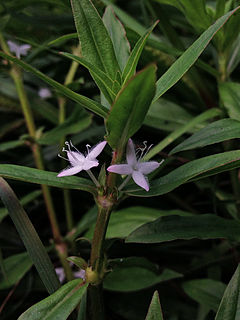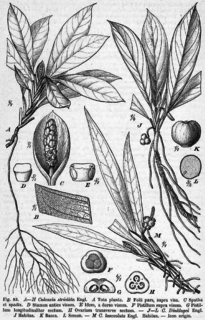Erythrococca is a plant genus of the family Euphorbiaceae, first described in 1849. It is native to Africa and the Arabian Peninsula.

Diodia is a genus of flowering plants in the family Rubiaceae. It was described by Carl Linnaeus in 1753. The genus is found from southern and eastern United States, South America, Central America, Mexico, the West Indies and tropical Africa.
Belonophora is a genus of flowering plants in the family Rubiaceae. It is found in Tropical Africa from Senegal east to Sudan and south to Angola. It was described by Joseph Dalton Hooker in 1873.
Calycosiphonia is a genus of flowering plants in the family Rubiaceae. It is native to tropical Africa from Ghana to Sudan to Mozambique.

Palisota is a genus of plant in family Commelinaceae, first described in 1828. It is native to sub-Saharan Africa.
Pausinystalia is a largely African genus of plant in the family Rubiaceae. As of the present time Pausinystalia contains the following 5 species:
Eremospatha is a genus of climbing flowering plants in the palm family found in tropical Africa. These rattans are uncommon in cultivation and poorly understood by taxonomists;. Closely related to Laccosperma, they differentiated by the near complete absence of bracts and bracteoles. The name is from Greek meaning "without a spathe".

Culcasia is a genus of flowering plants in the family Araceae, native to tropical Africa. Most of its species are climbers and resemble Cercestis except for the fact that they don't produce flagella.
- Culcasia angolensisWelw. ex Schott - western + central Africa from Senegal to Angola
- Culcasia annetiiNtépé-Nyamè - Ivory Coast, Cameroon, Liberia
- Culcasia bosiiNtépé-Nyamè - Cameroon, Gabon, Congo-Brazzaville
- Culcasia brevipetiolataBogner - Gabon
- Culcasia caudataEngl. - Zaïre
- Culcasia dinklageiEngl - western + central Africa from Liberia to Zaïre
- Culcasia ekongoloiNtépé-Nyamè - central Africa from Nigeria to Zaïre
- Culcasia falcifoliaEngl. - central Africa from Gabon east to Tanzania and south to Mozambique
- Culcasia glandulosaHepper - Ivory Coast, Sierra Leone, Liberia, Congo-Brazzaville
- Culcasia insulanaN.E.Br. - Zaïre, Cameroon, Gulf of Guinea Islands
- Culcasia lanceolataEngl. - Cameroon, Gabon
- Culcasia libericaN.E.Br. - Ivory Coast, Sierra Leone, Liberia, Togo
- Culcasia linearifoliaBogner - Cameroon, Gabon
- Culcasia loukandensisPellegr - Cameroon, Gabon, Congo-Brazzaville, Zaïre, Central African Republic
- Culcasia mannii(Hook.f.) Engl. - Cameroon, Gabon, Congo-Brazzaville, Nigeria, Equatorial Guinea
- Culcasia obliquifoliaEngl. - Cameroon, Gabon
- Culcasia orientalisMayo - Kenya, Tanzania, Mozambique, Zambia
- Culcasia panduriformisEngl. & K.Krause - Cameroon, Gabon
- Culcasia parvifloraN.E.Br. - western + central Africa from Liberia to Zaïre
- Culcasia rotundifoliaBogner - Gabon
- Culcasia sanagensisNtépé-Nyamè - Cameroon
- Culcasia scandensP.Beauv. - western + central Africa from Liberia to Angola
- Culcasia seretiiDe Wild - western + central Africa from Liberia to Zaïre
- Culcasia simiarumNtépé-Nyamè - western Africa from Ivory Coast to Cameroon
- Culcasia striolataEngl. - western + central Africa from Liberia to Congo-Brazzaville
- Culcasia tenuifoliaEngl. - western + central Africa from Liberia to Zaïre
- Culcasia yangambiensisLouis & Mullend. - Congo-Brazzaville, Zaïre
Corynanthe is a genus of flowering plants in the family Rubiaceae. It currently contains three accepted species, native to Africa.

Ancistrorhynchus is a genus of flowering plants from the orchid family Orchidaceae. It contains 16 species native to tropical Africa.
Atractogyne is a genus of flowering plants in the family Rubiaceae. It is found in western and western-central tropical Africa.
Aulacocalyx is a genus of flowering plants in the family Rubiaceae. It is found in tropical Africa.
Globulostylis is a genus of flowering plants in the family Rubiaceae. It comprises 8 species growing in Central Africa.
Craterispermum is a genus of flowering plants in the family Rubiaceae. It contains 16 species that occur in tropical Africa and Seychelles. It is the only genus in the tribe Craterispermeae, of which the divergence time is estimated at 34.8 million years ago.
Cremaspora is a genus of flowering plants in the family Rubiaceae. It is the only genus in the tribe Cremasporeae. It was described by George Bentham in 1849. The genus is widespread across much of sub-Saharan Africa from Senegal to Tanzania and south to Mozambique and Zimbabwe, in addition to Madagascar, Comoros, and Cape Verde. There are, however, only two currently recognized species.
Motandra is a genus of plant in the family Apocynaceae native to tropical Africa. As of August 2013 the World Checklist of Selected Plant Families recognises 3 species:
- Motandra guineensis(Thonn.) A.DC. - widespread from Liberia to Sudan and south to Angola
- Motandra lujaeDe Wild. & T.Durand - Gabon, Congo, Cabinda, Equatorial Guinea, Zaire
- Motandra poecilophyllaWernham - Gabon, Congo, Equatorial Guinea, Cameroon
- Motandra erlangeriK.Schum = Oncinotis tenuilobaStapf
- Motandra glabrataBaill. = Oncinotis glabrata(Baill.) Stapf ex Hiern
- Motandra viridifloraK.Schum. = Baissea viridiflora(K.Schum.) de Kruif
- Motandra welwitschianaBaill. = Oncinotis hirtaOliv.

Englerophytum is a group of trees in the family Sapotaceae described as a genus in 1914.

Cyanastrum is a genus of plants in the family Tecophilaeaceae, native to tropical Africa. It contains three currently recognized species.
Dictyophleba is a genus of flowering plants in the family Apocynaceae first described as a genus in 1898. It is native to Africa and to the Comoros Islands in the Indian Ocean.
- Dictyophleba leonensis(Stapf) Pichon - West Africa from Cameroon to Liberia
- Dictyophleba lucida(K.Schum.) Pierre - Comoros, central + southern Africa from Nigeria east to Tanzania and south to Zimbabwe
- Dictyophleba ochracea(K.Schum. ex Hallier f.) Pichon - central Africa from Nigeria to Zaire
- Dictyophleba rudensHepper - Cameroon
- Dictyophleba setosaB.de Hoogh - Cameroon, Gabon
- Dictyophleba stipulosa(S.Moore ex Wernham) Pichon - from Ivory Coast to Congo-Brazzaville





